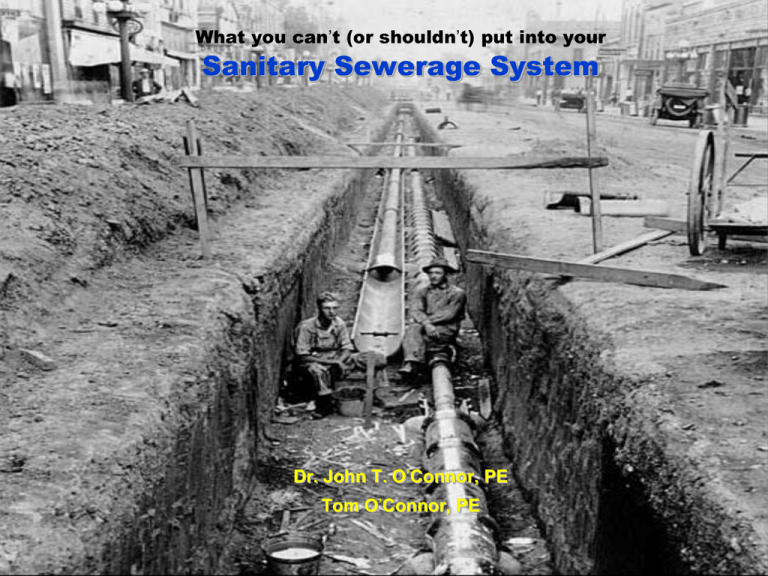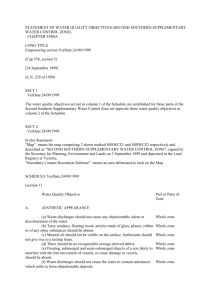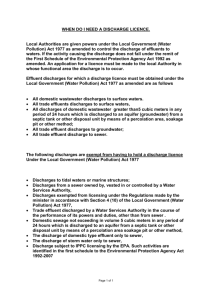What you can't (or shouldn't) put into your Municipal Sewerage System
advertisement

What you can’t (or shouldn’t) put into your Sanitary Sewerage System Dr. John T. O’Connor, PE Tom O’Connor, PE Early Sewerage Systems India, Pakistan: 3300-13000 BCE China: City of Linzi Rome Cloaca Maxima (Greatest Sewer), 600 BCE presided over by the goddess, Cloacina. Medieval Europe waterways functioned as sewers street drains = 'kennels' (canals, channels) Paris Brick-vaulted sewers, 1370 chamber pot contents prohibited U.S. Supreme Court: Carson v. Brockton (Mass.) Sewerage Commission (1901) Mandates, Taxes for Public Sewers? Municipal Socialism? Unconstitutional? Restrictions on Discharges Flammables Any liquid, solid, or gas gasoline, kerosene, naphtha, benzene, toluene, xylene, ethers, alcohols, ketones, aldehydes, peroxides and methyl ethyl ketone which may create a fire or explosion hazard or injure the sewerage system. Restrictions on Discharges Solids sand, mud, metal, glass, wood, paper, plastics, rags, rubber, latex, lime or other slurries, garbage, bones, hair, human parts, hides or fleshings, animal guts or tissues, feathers, ashes, cinders, stone or marble dust, straw, shavings, grass clippings, spent grains, spent hops, tar, asphalt residues, residues from refining or processing fuel or lubricating oil, grease, glass grinding or polishing wastes capable of causing obstruction to the flow in sewers, or interfering with the proper operation of the wastewater system. Restrictions on Discharges Stinky Stuff Noxious or malodorous liquids, gases or solids which prevent safe entry into sewers for purposes of inspection, maintenance or repair. Restrictions on Discharges Poisons & Pharmaceuticals Mercury, polychlorinated biphenyls (PCBs), phenanthrene or pesticides: dieldrin, chlordane, 1,1,1-Trichloro-2,2-bis(p-chlorophenyl)-ethane (4-4 DDT), demeton, endosulfan I, endosulfan II, endrin, guthion, heptachlor, malathion, methoxychlor, mirex, parathion, acrolein, aldrin, TDE, DDE, Hexachlorocyclohexane, lindane, benzene-cis-hexachloride and benzenetranshexachloride (BHC), hexachlorocyclopentadiene and toxaphene Restrictions on Discharges Metals + Toxins Metals Antimony Arsenic Boron Cadmium Chromium Copper Lead Nickel Selenium Silver Zinc Organics Cyanide Chlorinated Naphthalenes; Fluoranthene Hexachlorobutadiene; Pentachlorophenol Phenolic Compounds; 2 -chlorophenol 2 ,4-dichlorophenol; 2 ,4-dimethylphenol 4,6-dinitro-o-cresol; 2 ,4-dinitrophenol 2 -nitrophenol; 4-nitrophenol p-chloro-m-cresol; 2 ,4,6-trichlorophenol Total Toxic Organics Trichloroethylene260 Restrictions on Discharges F-O-G fats, oils, grease of vegetable or animal origin which may solidify or become viscous. Restaurants are commonly required to install and maintain grease traps. Used Oil and Grease is scavenged for rendering into lard, tallow, soap, biodiesel. Restrictions on Discharges Pathogens disease-causing organisms biological waste, hospital or medical wastes, animal or veterinarian wastes Restrictions on Discharges Water Swimming Pool Water Storm Water Ground Water Dewatering Drainage Subsurface Drainage Tidewater Accumulated Surface Water Cooling Water Industrial Process Waters Foundation Water Manhole Water Infiltration and Inflow (I & I) Smoke Bomb Testing Infiltration/Inflow causes dilution in sanitary sewers, decreasing the efficiency of wastewater treatment. Smoke bombs are used to check sanitary sewers for illegal storm water connections & groundwater infiltration. Restrictions on Discharges Impairers of Treatment Capacity Acids, Plating Solutions (neutralized or not) Dyes (causing discoloration or turbidity) Hot Liquids (temperatures >150° Fahrenheit) Corrosive Liquids [pH < 5.5 (acidic) or > 10.5 (alkaline)] Radioactive Wastes (Hospitals & Reactor Labs) Strong Wastes (BOD > 400 mg/l; e.g., septage) Hazardous Waste (or wastewater which has come in contact with hazardous waste) Restrictions on Discharges Bill Stuffers Wastewater Utilities campaign to stop dangerous, extraneous and untreatable substances from being discharged to sanitary sewers. Even drain cleaner is cited as unsuitable for discharge to sewer drains. Restrictions on Discharges What is Acceptable? Please don’t injure my biological processes or increase the organic loads I have to bear. Household Water Use Conservation Water Utilities urge consumers to fix leaks; “If its yellow, let it mellow; if it’s brown, flush it down” install flow restrictors on showers and faucets; purchase low-flow toilets; flush less frequently, and buy water-efficient washing machines 40 Troubled by Restrictions on Sewer Discharges ? Think of it from my Point of View! I work down the manhole With a guy named Bruce. And we are in charge Of all the refuse. He lets me go first While he holds the lid. I’m telling you, sheesh… What a sweet kid. I work in the sewer, It’s a very hard job. You know they won’t hire Just any old slob. You don’t have to wear A tie or a coat. You just have to know How to float. A funny thing happened To Bruce yesterday. The tide came along He got carried away. He come out in Jersey. But it’s O.K. now. Cause that’s where He lives anyhow. My father he worked In the sewer Uptown. I followed his footsteps And worked my way down. That’s how I began In this here industry. I just sort of fell into it. Sheesh, lucky me.







